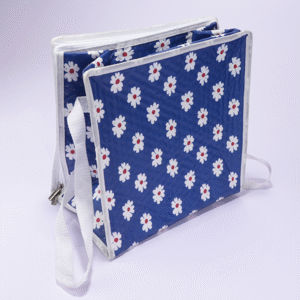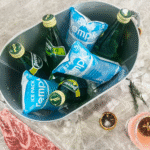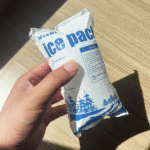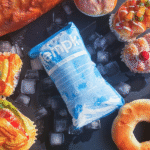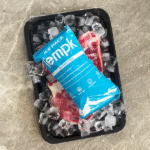What Does the Cold Chain Mean and Why Is It Vital Today?
The term Kaltkette refers to the specialised logistics processes used to handle, store and transport temperature sensitive products—from vaccines and biologics to seafood and fresh produce—under strict temperature controls to preserve quality from production to consumption. Unlike a standard supply chain, the cold chain relies on continuous refrigeration and monitoring across every stage. This ensures that delicate goods remain within defined temperature ranges during manufacturing, Lagerung und Vertrieb. In 2025, the importance of an effective cold chain has never been greater. With the global cold chain logistics market estimated at US$436.30 billion in 2025 and projected to exceed US$1.3 trillion by 2034, businesses that depend on temperature controlled goods must prioritise robust cold chain strategies to avoid spoilage, comply with stringent regulations and maintain customer trust.
The fundamental meaning of the cold chain and how it differs from a conventional supply chain.
The major components and temperature ranges required to maintain product integrity.
Emerging innovations and sustainability trends shaping cold chain logistics in 2025.
Practical tips for businesses to enhance cold chain efficiency, resilience and compliance.
Answers to frequently asked questions about cold chain management.
What Is the Cold Chain? Wie funktioniert es?
Im Wesentlichen, the cold chain is a temperature controlled supply chain designed to protect sensitive products from degradation by maintaining strict temperature ranges throughout production, Lagerung und Vertrieb. This system is not limited to the food industry; it spans pharmaceuticals, Biotech, Chemikalien, floral products and numerous other sectors. At its core, the cold chain combines science, technology and process disciplines, deploying refrigeration equipment, insulated packaging and real time monitoring to ensure products remain safe and effective.
Maintaining proper temperature is essential because minor variations can reduce efficacy or render products unsafe. Zum Beispiel, a vaccine exposed to temperatures outside the recommended range can lose potency, while seafood that warms above 4 °C can spoil quickly. To prevent such incidents, cold chain logistics rely on four interdependent components: cooling systems, cold storage facilities, temperature controlled transportation and precise processing/distribution methods. Each component works in concert to keep products within their optimal temperature window.
Components of the Cold Chain Explained
Cooling Systems – These include compressors, Kondensatoren, evaporators and other refrigeration technologies used to lower product temperatures to the desired range. For highly sensitive goods like biologics, cryogenic freezers can maintain temperatures as low as −80 °C.
Temperature Controlled Storage – Refrigerated warehouses employ insulated panels, automatisierte Lager- und Bereitstellungssysteme (AS/RS) and high density pallet racking to minimize temperature fluctuations. Some facilities now integrate solar powered cooling or energy efficient systems to reduce carbon footprints.
Transportation Infrastructure – Insulated trucks, reefer containers, railcars and specialized air cargo maintain temperature during transit. Emerging solutions include portable cryogenic freezers capable of ultra low temperatures for cell and gene therapies.
Monitoring and Control Systems – Internet of Things (IoT) Sensoren, GPS devices and data loggers transmit real time temperature and location data. These tools enable proactive interventions if conditions deviate.
Quality Assurance Protocols – Procedures like temperature mapping, emergency response planning and first in, zuerst raus (FIFO) inventory management ensure products comply with regulatory standards and minimize waste.
Typical Temperature Ranges in Cold Chain Logistics
Maintaining specific temperature ranges is central to cold chain operations. Industry guidelines classify these ranges as follows:
| Temperaturbereich | Zweck | Example Products | Warum ist es wichtig |
| Ambient (59–86 °F / 15–30°C) | Kontrollierte Raumtemperatur für haltbare oder risikoarme Waren | Trockenfutter, bestimmte Arzneimittel | Minimale Kühlkosten; ensure proper ventilation to avoid heat buildup |
| Cool (50–59 °F / 10–15 ° C.) | Milde Kühlung, um Geschmack und Textur zu bewahren | Käse, frische Produkte | Reduziert den Verderb; erfordert isolierte Behälter und kurze Transportzeiten |
| Gekühlt (32–50°F / 0–10 ° C) | Verhindert Bakterienwachstum und sorgt für Frische | Impfungen, Milchprodukte | Strenge Temperaturregelung; Nutzen Sie IoT-Sensoren zur Echtzeitüberwachung |
| Gefroren (−22–32 °F / −30–0 °C) | Langzeitkonservierung verderblicher Waren | Fleisch, Meeresfrüchte, gefrorene Desserts | Erfordert Tiefkühlgeräte und Redundanzpläne für Stromausfälle |
| Ultra Low (below −80 °C) | Preservation of biologics, Zell- und Gentherapien | Cell therapies, mRNA-Impfstoffe | Demands cryogenic freezers and redundant power to prevent catastrophic loss |
These ranges illustrate how different products necessitate distinct environments. Deviations can compromise safety and quality, underscoring the need for rigorous monitoring.
Why Does the Cold Chain Matter More in 2025?
Demand for temperature controlled logistics has accelerated since the COVID 19 pandemic and shows no signs of slowing. Analysts estimate the global cold chain logistics market will top US$436 billion in 2025 and could surpass US$1.3 trillion by 2034, reflecting a 13.46 % durchschnittliche jährliche Wachstumsrate (CAGR). This growth stems from several factors:
Ausweitung des globalen Lebensmittelhandels – Consumers increasingly expect access to fresh and exotic foods year round, boosting investment in cold chain infrastructure.
Booming e commerce and online grocery – The shift to online grocery and meal kit services requires reliable temperature controlled delivery networks.
Technologische Innovation – Advances in refrigeration, IoT sensors and artificial intelligence (Ai) enable real time monitoring and predictive maintenance, improving reliability and efficiency.
Aufstrebende Märkte und Urbanisierung – Rising incomes and changing diets in emerging economies create new demand for cold chain infrastructure.
Stricter regulations – Authorities worldwide enforce rigorous standards for pharmaceuticals and food safety, making compliance with Good Distribution Practice (BIP), Hazard Analysis Critical Control Point (Haccp) and other frameworks mandatory.
How Does the Cold Chain Differ from a Traditional Supply Chain?
A traditional supply chain moves products from producers to consumers without strict temperature regulation. Dagegen, the cold chain requires specialized equipment, insulation and constant monitoring to maintain product integrity. Critical differences include:
Temperaturregelung: Cold chain shipments must stay within specific ranges; failure to do so can degrade product quality or cause safety risks.
Equipment and Infrastructure: The cold chain uses refrigerated trucks, Reefers, cold rooms and specialized packaging solutions like gel packs, Trockeneis, liquid nitrogen and insulated quilts to maintain temperature.
Monitoring and Documentation: Cold chain operators must log temperatures throughout transport and maintain records for audits. IoT devices and data loggers provide real time visibility.
Vorschriftenregulierung: Governments and international bodies impose strict regulations—such as GDP for pharmaceuticals and HACCP for food—to ensure safety and efficacy.
Cost and Complexity: Maintaining a cold chain requires higher capital investment and operating costs. Jedoch, it reduces spoilage, protects brand reputation and can ultimately increase profitability.
How Is Sustainability Shaping Cold Chain Practices?
Sustainability has moved from a buzzword to a core requirement in cold chain operations. The food and beverage cold chain alone accounts for about 4 % of global greenhouse gas emissions. Energy intensive refrigeration equipment, leakage of synthetic refrigerants and food waste are major contributors. Als Antwort, companies are adopting eco friendly practices:
Energy Efficient Refrigeration: Fortschrittliche Isolierung, variable speed compressors and natural refrigerants reduce power consumption. A coalition of companies is promoting the “Move to −15 °C” initiative to shift storage temperatures from −18 °C to −15 °C, cutting energy use without compromising product safety.
Renewable Energy Integration: Facilities incorporate solar and wind power to operate refrigeration units, with some achieving EDGE Zero Carbon certification. In Südostasien, solar powered cold storage units are emerging as a solution to high energy costs.
Eco Friendly Packaging: Recyclable insulated containers, biodegradable wraps and reusable cold packs reduce waste and environmental impact. This shift aligns with the European Union’s Ecodesign for Sustainable Products Regulation, which pushes industries toward circular practices.
Food Waste Reduction: Cold chain logistics helps prevent spoilage and loss. Mehr als 1 billion tons of food are wasted every year, contributing 8–10 % of global greenhouse gas emissions. Efficient cold chain management preserves product quality and reduces waste.
Navigating Climate Change and Geopolitical Disruptions
Extreme weather events—such as floods and droughts—have strained cold chain infrastructure in regions like southern Brazil and the Panama Canal. Gleichzeitig, geopolitical events and trade disputes introduce tariffs and route disruptions that delay shipments, increasing the risk of temperature excursions. Building resilience requires diversifying transportation routes, maintaining strategic stockpiles and partnering with logistics providers capable of navigating political and environmental challenges.
Emerging Technologies and Innovations Shaping the Cold Chain in 2025
Technological advances are transforming cold chain logistics, Verbesserung der Sichtbarkeit, Effizienz und Nachhaltigkeit. Several innovations stand out for 2025:
Künstliche Intelligenz (Ai) and Predictive Analytics
AI analyses real time and historical data to optimise delivery routes, predict equipment failures and forecast demand. Automatisierte Lager- und Bereitstellungssysteme (AS/RS) and robotic handling systems enable precise product handling and reduce labour costs. Predictive analytics helps companies adjust shipment schedules and prevent temperature excursions. AI also supports route optimisation by considering traffic and weather data to prevent delays, a crucial capability for pharmaceutical shipments.
Internet der Dinge (IoT) and Smart Sensors
IoT sensors and GPS trackers transmit real time temperature, Luftfeuchtigkeit und Standortdaten, um sofortige Korrekturmaßnahmen zu ermöglichen. Smart sensors also alert operators to unsafe conditions, reducing operational risks and product loss. The ability to remotely monitor conditions ensures compliance and provides transparency for customers and regulators.
Blockchain for Traceability
Blockchain technology offers tamper proof records of product movements and conditions, enhancing traceability and transparency. By providing an immutable audit trail, blockchain helps verify compliance with regulatory requirements and detects any potential tampering. This increased trust is particularly valuable for high value pharmaceuticals and sensitive food products.
Solar Powered and Alternative Energy Storage
High energy costs have encouraged the adoption of solar powered cold storage units. In Südostasien, solar systems reduce energy costs compared with grid electricity and provide reliable backup during outages. Innovations in energy storage, such as phase change materials and thermal batteries, help maintain temperatures during power interruptions.
Portable Cryogenic Freezers
Advances in portable cryogenic freezers allow biologics and cell therapies to be transported at ultra low temperatures (−80 °C to −150 °C). These units often integrate IoT trackers for real time monitoring and notifications. Portable ultra low freezers improve access to advanced treatments in remote regions and reduce the reliance on centralized facilities.
Automatisierung und Robotik
Robotic arms, autonomous mobile robots (AMRs) and pallet shuttle systems are becoming staples in cold storage facilities. They handle goods seamlessly at temperatures as low as −25 °C. Companies like Movu Robotics deploy AMRs to transport pallets and roll cages across cold and ambient zones, while AI driven inventory tools minimize errors in order fulfillment. Automation enhances efficiency, increases safety and compensates for labour shortages.
AI Driven Inventory and Warehouse Optimisation
AI helps optimize facility layouts and storage densities, creating more space and improving safety. Intelligent systems monitor performance indicators, schedule predictive maintenance and reduce equipment downtime. These advancements lead to dynamic space optimization and lower operational costs.
Built to Suit Facilities and Modernisation
Many cold storage facilities were constructed 40–50 years ago and now struggle to meet modern demands. Operators are investing in modernizing these facilities with automation, bessere Isolierung, natural refrigerants and integrated monitoring systems. Built to suit solutions customize facilities to meet specific operational needs and optimize costs.
How to Build a Resilient and Efficient Cold Chain: Practical Tips
Incorporating the latest trends and technologies is essential, but practical strategies ensure that your cold chain remains robust and compliant. Consider the following recommendations:
Develop Contingency Plans: Establish emergency response protocols for equipment failures, power outages and transport delays. Stock backup generators and contingency cooling materials (Z.B., dry ice or phase change materials).
Implement IoT Monitoring: Equip storage units and vehicles with IoT sensors to track temperature, Luftfeuchtigkeit und Standort in Echtzeit. Automated alerts enable immediate corrective action.
Train Personnel: Regularly educate your team on proper handling procedures, data logging and emergency responses. A well trained workforce reduces errors and ensures compliance.
Use Sustainable Packaging: Opt for recyclable and biodegradable insulated containers and reusable cold packs to reduce environmental impact. Not only does this improve sustainability, but it also aligns with customer expectations and regulatory trends.
Optimize Routes with AI: Use AI powered route optimization tools to factor in traffic, Wetter- und Lieferfenster. Such tools reduce fuel consumption and prevent temperature deviations during transit.
Leverage Built to Suit Facilities: Consider partnering with logistics providers that offer built to suit cold storage solutions, enabling you to scale capacity efficiently and incorporate the latest technologies.
Fallstudie: In 2024, CJ Logistics America launched a modern cold storage facility near Kansas City, featuring automated systems, Energieeffiziente Kühlung und IoT-Überwachung. The facility’s design demonstrates how integrating technology and sustainability can meet growing demand while minimizing energy use.
Cold Chain Meaning: Long Tail Topics and Deep Dives
To enrich your understanding, we explore several related questions that delve into the nuances of cold chain logistics.
How Does Cold Chain Management Enhance Food Safety?
Cold chain management ensures that perishable food items remain within safe temperature ranges, preventing bacterial growth and preserving freshness. In der Lebensmittelindustrie, maintaining an efficient cold chain is not just about compliance; it’s a strategic differentiator. Poorly stored or transported food can spoil or become contaminated, leading to financial losses and damage to consumer trust. Real time monitoring and traceability systems provide visibility across the supply chain, enabling rapid response to any deviations.
Temperature Control for Different Food Categories
| Food Category | Recommended Range | Grund | Wirkung für Sie |
| Frische Produkte | 32–55°F (0–13°C) | Slows ripening and reduces microbial growth | Verlängert die Haltbarkeit, minimizes spoilage |
| Milchprodukte | 33–45°F (1–7°C) | Prevents bacterial growth and maintains flavour | Ensures safety and quality |
| Fleisch und Meeresfrüchte | 0–32 °F (−18–0 °C) | Halts bacterial activity and preserves texture | Maintains freshness and prevents pathogens |
| Gefrorene Lebensmittel | −22–0 °F (−30–0 °C) | Allows long term storage without quality loss | Provides long shelf life and reduces waste |
What Role Do Regulatory Standards Play?
Regulatory standards ensure that cold chain operators meet minimum safety and quality requirements. Einhaltung Gute Vertriebspraxis (BIP) in pharmaceuticals and Hazard Analysis Critical Control Point (Haccp) in food logistics is mandatory. Additional standards like Safe Quality Food (SQF) Und British Retail Consortium (BRC) certifications have become benchmarks for warehouses and distribution centers, replacing older certifications and ensuring traceability and food safety. Regulatory frameworks also address environmental sustainability; Zum Beispiel, the European Union’s Ecodesign for Sustainable Products Regulation encourages circularity and greener practices.
How Do Geopolitical Events Influence the Cold Chain?
Global supply chains face ongoing disruptions from geopolitical events, such as tariffs and trade restrictions. These events can delay shipments and create bottlenecks for perishable goods. In 2025, the implementation of tariffs in the United States and other geopolitical shifts are prompting companies to rethink routes and stock inventory strategically. Building resilience involves diversifying transportation networks and incorporating regional warehouses to buffer against delays.
Why Are Plant Based and New Products Driving Change?
The rise of plant based proteins and alternative foods is reshaping cold chain requirements. Bloomberg projects that the plant based food market will reach US$162 billion by 2030, aufwärts von US$29.4 billion in 2020. Small and medium sized businesses producing these goods often lack experience with global logistics. Cold chain providers must adapt to serve these companies by offering flexible distribution networks and scalable storage capacity.
What Innovations Are Emerging in 2025?
Innovations include AI enabled warehouse automation, predictive maintenance, Blockchain-Rückverfolgbarkeit, solar powered storage and cryogenic transport. AI driven systems can optimize space and reduce downtime. Smart sensors offer real time insights and predictive alerts. Portable freezers maintain ultra low temperatures for advanced biologics. These technologies collectively enhance visibility, Nachhaltigkeit und Zuverlässigkeit.
2025 Trends and Market Outlook for Cold Chain Logistics
Das Jahr 2025 marks a pivotal moment for the cold chain sector. Several trends are shaping the industry:
Market Changes and Resilience
Geopolitical unrest has influenced transit times and capacity availability for cold chain shipments. Disruptions such as port delays and tariffs are prompting logistics providers to improve resiliency by diversifying routes and investing in integrated visibility software. Market growth remains robust: the cold chain logistics market is projected to grow from US$324.85 billion in 2024 to US$862.33 billion by 2032, Ausstellen einer 13 % CAGR.
Stronger Visibility and Digital Integration
Companies are investing in software that provides end to end visibility. Continuous data collection enables proactive intervention when disruptions occur, improving reliability. Enhanced management visibility also helps businesses limit risk and prevent accidents.
New Products and Consumer Preferences
The rise of plant based proteins, gluten free foods and organic certified products is creating new supply chain requirements. These products often come from small or mid sized companies that require specialised cold chain expertise and scalable logistics solutions. Cold chain providers must plan for growing volumes as these products shift from niche to mainstream.
Facility Modernisation and Upgrades
Many cold storage facilities were built decades ago and now face efficiency issues and regulatory pressures. Operators are investing in modern refrigeration systems, Automatisierung, and natural refrigerants to replace ageing infrastructure. Aging facilities will continue to be upgraded or replaced, integrating automation and sustainability features.
Sustainable Practices and Green Logistics
Environmental sustainability is no longer optional. Cold chain operations are adopting renewable energy sources, eco friendly packaging and energy efficient refrigeration. Initiatives like the Move to −15 °C coalition promote energy saving without compromising product integrity. Companies are also investing in green transport, using biofuels and electric vehicles.
Adoption of AI, IoT and Automation
AI and IoT continue to revolutionise cold chain logistics. Vorausschauende Wartung, automated warehouses and IoT powered monitoring create a more resilient and efficient supply chain. The increasing use of autonomous mobile robots (AMRs) and pallet shuttle systems allows seamless handling of goods at low temperatures.
Resilience and Supply Chain Planning
To cope with disruptions—from geopolitical events to climate change—companies are building strategic stockpiles, diversifying transportation networks and investing in regional cold storage hubs. Resilience also includes contingency planning and flexible distribution strategies.
Häufig gestellte Fragen (FAQ)
Q1: What does the cold chain mean?
The cold chain refers to specialized logistics processes that maintain temperature controlled conditions for sensitive products from production to consumption. It combines refrigeration, Isolierte Verpackung, transportation and monitoring to preserve quality and safety.
Q2: Why is maintaining temperature so important?
Temperature fluctuations can degrade product quality, reduce efficacy or cause spoilage. Zum Beispiel, vaccines may lose potency outside their recommended range, while perishable foods can spoil, leading to waste and health risks. Continuous temperature control prevents these issues.
Q3: How is the cold chain adapting to sustainability demands?
Companies are adopting energy efficient refrigeration systems, renewable power sources and recyclable packaging. Initiatives like the Move to −15 °C coalition aim to reduce energy use by standardising colder storage temperatures. Reducing food waste also plays a critical role.
Q4: What technologies are transforming the cold chain in 2025?
Künstliche Intelligenz (Ai), IoT -Sensoren, Blockchain, automation and portable cryogenic freezers are among the technologies revolutionising the industry. These tools improve visibility, predict maintenance needs and enhance energy efficiency.
Q5: What long term trends will shape cold chain logistics?
Long term trends include growth in plant based and biologic products, strengere Vorschriften, investment in modern infrastructure and continued adoption of AI and automation. Sustainability and resilience will remain key priorities as climate change and geopolitical events continue to impact global supply chains.
Schlussfolgerung und Empfehlungen
Um zusammenzufassen, the cold chain meaning encompasses the entire temperature controlled logistics process that ensures sensitive goods maintain their integrity from origin to consumption. As the global market surpasses US$436 billion in 2025, businesses must understand the critical components—cooling systems, Lagerung, Transport, monitoring and quality assurance—to deliver safe, high quality products. Der Aufstieg des E-Commerce, plant based foods and biologics, coupled with stricter regulations and sustainability requirements, demands proactive investment in cold chain infrastructure and innovation.
Next Steps for Your Organisation:
Assess Your Cold Chain: Evaluate existing equipment, storage facilities and transportation modes. Identify gaps and opportunities to integrate IoT sensors, AI analytics and sustainable refrigerants.
Implement Real Time Monitoring: Adopt smart sensors and data platforms for continuous visibility and faster response to deviations.
Upgrade Packaging and Facilities: Transition to eco friendly, recyclable packaging and modernise facilities with energy efficient systems and automation.
Develop Contingency Plans: Build resilience through contingency protocols, diversified routes and strategic stockpiles.
Bleib informiert: Monitor regulatory updates, emerging technologies and market trends. Collaborate with experienced logistics partners to navigate changing landscapes.
Über Tempk
Tempk is a specialist in cold chain logistics and temperature controlled packaging solutions. We design and manufacture insulated boxes, Gelpackungen, dry ice alternatives and IoT enabled monitoring devices that keep products within precise temperature ranges. Our research and development center continuously innovates to deliver eco friendly and reusable packaging options. We understand the complex demands of the pharmaceutical, food and biotech industries and offer tailored solutions that ensure product integrity, regulatory compliance and cost efficiency.
Aufruf zum Handeln: Contact Tempk today to discuss your cold chain requirements. Our experts will help you select the right packaging solutions, implement real time monitoring and build a resilient cold chain that meets the evolving demands of 2025 und darüber hinaus.






